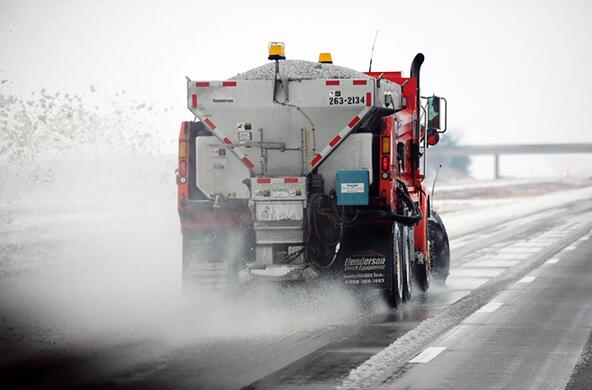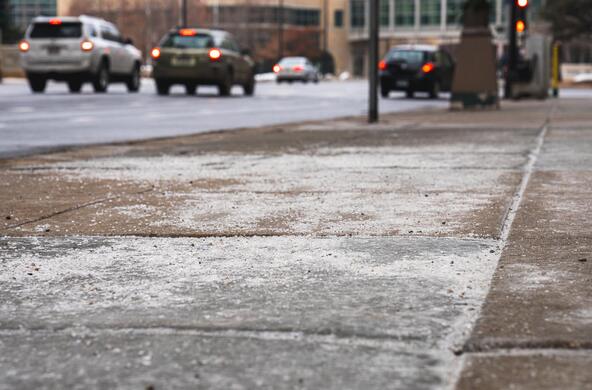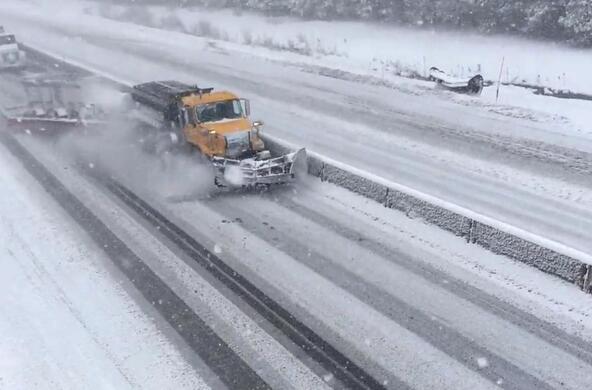By the handful, locals met the latest winter storm with rock salt, reaching into five-pound bags over and over to scatter ice-melting crystals onto recently shoveled driveways and sidewalks. On a larger scale, plow trucks equipped with spreaders did much the same on local roads.
The wintertime routine in Lancaster County, like in most of the country where snow and ice are common this time of year, involves applying salt and chemical de-icing solutions to roadways, often in mix with anti-skid materials like sand.
But it’s a road-safety routine that comes with a cost, specifically the polluting of local soils and waterways, including those that serve farms and homes alike.
“Anything that ends up on the ground has the potential to end up in our waterways,” said Jennifer Fetter, a local water resources expert with Penn State Extension. “It’s going to go somewhere. It doesn’t just disappear.”
Like other pollutants, salt used during winter storms can be carried from pavement into local streams and rivers by melting snow and stormwater, Fetter said.
Robert Walter, a geoscience professor at Franklin & Marshall, explained why that is “definitely a problem.”
Mostly, he focused on how salt can impact local freshwater ecosystems, where it can harm both wildlife and vegetation.
To back his point, Walter pointed to a report from the Cary Institute of Ecosystem Studies, a New York-based nonprofit organization that researches environmental issues.
The report outlines a clear link between the use of ice-melt and rising saltiness of freshwater — a problem that can remain a threat to those ecosystems for decades, not just during winter months. Freshwater fish and animals are not built to live in those salty conditions, according to the report.
“Lethal levels are rarely reached, except in some urban water bodies, or intermittently during the winter right after road salt application,” the report’s authors write. “However, sublethal salt levels present in many streams can impair the health, reproduction and behavior of many organisms — especially with extended exposure.”
On top of that, roadside soils and wetlands, may no longer be able to support native plants, Fetter said. In fact, increasingly salty conditions in soil along roadways have led to the growth of invasive, salt-tolerant species like phragmites, a reed, that’s spreading locally, she said.
Harry Campbell, the Chesapeake Bay Foundation’s science policy and advocacy director in Pennsylvania, wrote about some of the same issues in a column shared recently by a foundation spokesman.
“Salt that stays on the land can be harmful to plants as evidenced by dead or dying, seemingly burned-out vegetation found along many roadways,” he wrote. “This affects the ability of these plants to support valuable wildlife.”
Fetter said salt-related contamination of groundwater is another concern. Runoff pollutes the groundwater that feeds local wells, which are used to draw drinking water for livestock. While not lethal, contaminated well water can have a bad taste, meaning that farm animals will drink less, Fetter said, adding that in the case of dairy cows, that could mean less milk output.
In rural communities, humans often drink that well water, too, Walter said. The Cary Institute report noted that salt pollution of drinking water has been found “to affect people on low sodium diets” in some places.
Tons of salt
Over the past five years, an average of 844,000 tons of salt was spread annually on state roads across Pennsylvania, according to Dave Thompson, spokesman for PennDOT’s District 8, which includes Lancaster County. Last winter, in Lancaster County, 52 PennDOT plows spread 2,500 tons, Thompson said.
That’s apart from what was spread by plows clearing local roads for municipal governments or those working to clear parking lots for private customers.
PennDOT plows spread sodium chloride, as well as crushed limestone, which is used as an antiskid material, Thompson said.
“PennDOT employs multiple methods, policies, programs and measures to keep pollution prevention at the forefront, including during winter services,” Thompson said, not providing specific examples. “The department adheres to nationally recognized best practices for salt application that minimizes the use of salt while balancing the safety of the traveling public.”
Fetter acknowledged the need to keep roads safe and drivable during winter storms. She urged both private residents and plow truck operators to use discretion by treating pavement only when necessary and using only as much salt and antiskid as is needed.
“Using too much is obviously going to have a greater impact,” she said.








